Exterior views of Hagia Sophia
Faculty Views on Arch(BE]Log, 2013.
Arch [BE] Log is a blog and forum for current students, alumni, and faculty at the University of Washington, Department of Architecture.
Sometimes it takes centuries, state-of-the-art technology, and new approaches to demystify the wisdom of the past and reveal its secrets. The domed structures from the Byzantine period provide examples of architectural grandeur and unique experiential qualities. Many scholars had focused on the historical context within which these edifices were built, the unprecedented structural ingenuity, and the resulting spatial qualities. These historical domed structures also create exceptional luminous environments. The most famous example from the period is, of course, Hagia Sophia, the great Byzantine church built in the 6th Century.
You cannot find a book or scholarly article about Hagia Sophia that does not mention its lighting qualities. However, it is very surprising to find that lighting is mostly mentioned briefly and through mere observations. It is defined as poetic and mystical. The lack of any systematic quantitative lighting analysis is a major obstacle in understanding and demystifying the luminous qualities of this unique structure. It pointed to a need for further research on the topic, so I decided to take up the challenge.
Exterior views of Hagia Sophia
The primary focus of my research is to develop innovative computer-based lighting performance analysis tools, techniques, and metrics. I have spent two months of my sabbatical in Istanbul, Turkey, to do lighting research on historical domed structures from Byzantine and Ottoman periods. I knew that I have to combine the available tools and techniques with new computational lighting measurement, simulation, and analysis methods to provide an in-depth analysis of the lighting quantities and distribution under dynamic daylight conditions.
Hagia Sophia is a museum visited by more than 10,000+ people every day. It is the most visited tourist destination in Turkey. After going through a long bureaucratic red tape, I was given the opportunity to do lighting field research in Hagia Sophia on Mondays, which is closed to public, and from sunrise to sunset, which is beyond regular operation hours. I spent three consecutive Mondays in Hagia Sophia. In each one of the data collection days, I was happy to bypass the notorious rush-hour car and human traffic in Istanbul (a city with 15 million population) to reach my destination before sunrise. Carrying my 30 lb. lab equipment, I would be greeted by the security guards outside Hagia Sophia, and by the resident cat Gli inside the building.
Interior views of Hagia Sophia
The research required a well-established procedure to collect, generate, and analyze high resolution visual and numerical lighting information in a quick and efficient manner. I decided to collect per-pixel lighting data through the High Dynamic Range (HDR) photography method. Traditional photography techniques are limited with the dynamic lighting range that they can record. In HDR photography, computational techniques are used to assemble multiple exposure photographs into one digital image. With appropriate data collection, post-processing, and calibration procedures, these images incorporate accurate lighting values.

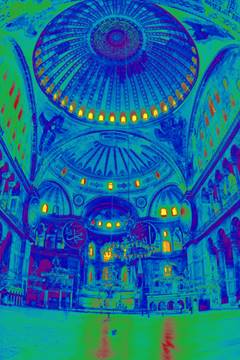
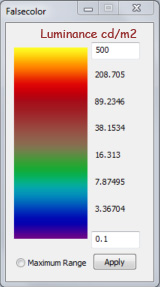
Luminance map from the Entrance, September 17 2012, 10:15am
Data collection lasted from sunrise to sunset every 15 minutes at three locations. Two of the camera systems were located inside Hagia Sophia while a third system was positioned in a nearby terrace to capture the sky conditions. An important piece of this research was automating the capturing process to be able to collect simultaneous lighting data. New in-house software, hdrscope, was used for automated image capture. hdrscope is developed by my former student Viswanathan Kumaragurubaran, as part of his M.Sc. thesis in Architecture (Design Computing). It is freely available and can be downloaded from http://courses.washington.edu/hdrscope/

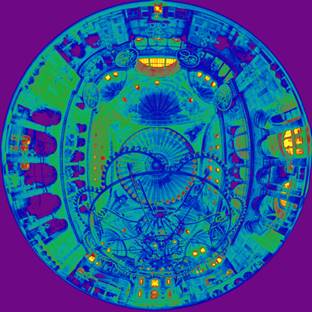
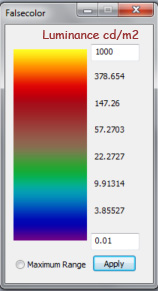
Luminance map of the dome, September 24, 12:30pm
Extensive data was collected in-situ, and it took months to post process these images. One of the most important highlights of the field work was being in Hagia Sophia throughout the entire day – almost alone. Historian Procopius described the lighting in Hagia Sophia in the 6th century as an interior that “is singularly full of light and sunshine; you would declare that the place is not lighted by the sun from ‘without’, but that the rays are produced ‘within’ itself, such an abundance of light is poured into this church....”. It is something quite exciting to be able to experience the physical equivalence of this sentence in the 21st century, even after the restorations and alterations Hagia Sophia has gone through. The lighting in Hagia Sophia is characterized by the progression of sunlight patches and gleaming reflections. A casual visitor spends half an hour, which is not enough to experience the exquisite-time based light progression in the building. Spending the whole day was the key to appreciate the unique connections of building geometry, material properties, and sun-path that holds the key to the ancient wisdom.
One also has to hail to the wisdom of animals. Resident cat Gli was born in Hagia Sophia. When he was not greeting the visitors or supervising my data collection process, he slept. The spots he chooses to sleep coincides with the light pools on the marble floor. His movements can be captured and used as a sun-path diagram.
Following the sun-path diagram: The coziest spot in Hagia Sophia is full of sunshine
After I came back to Seattle, I have spent hours in front of my computer to develop a new technique for extrapolation of dynamic daylighting simulations from a limited number of HDR photographs. The captured lighting values from my field trip correspond to the particular sky conditions occurring at that time. A more meaningful evaluation of daylighting performance must take into consideration a wide range of naturally occurring sky conditions and sun positions. The dynamic character of daylight inside the Hagia Sophia (or any daylit building) is negotiated between the outdoor conditions and the openings of the structure (windows) that serve as the primary sources of illumination for the interior, along with the interreflections that serve as the secondary sources. As I am preparing to present a paper titled “Dynamic daylighting simulations from static high dynamic range imagery using extrapolation and daylight coefficient methodologies” at the end of the summer in the upcoming 2013 Building Simulation Conference, I know that my summer is going to be exciting with the preparation of a demo that features the majestic Hagia Sophia.
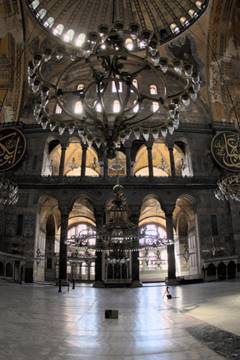
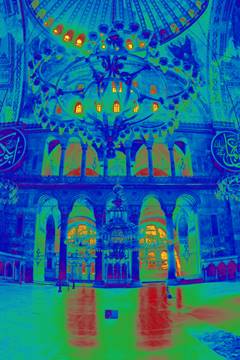
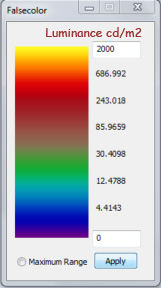
Luminance map from the side view, September 24, 4:15 pm
All of the photographs are taken and generated by the author, © Inanici 2012.
Related Publications:
Inanici M. Lighting Analysis of Hagia Sophia. Annuals of Hagia Sophia Museum: No. 17, Istanbul: December 2014, 128-202 (English/Turkish). © Hagia Sophia Museum, online version republished here with permission.
Inanici M. “Dynamic Daylighting Simulations from Static High Dynamic Range Imagery using Extrapolation and Daylight Coefficient Methodologies,” International Building Performance Simulation Association (IBPSA) 2013 Conference, Chambery, France, August 25-28, 2013.